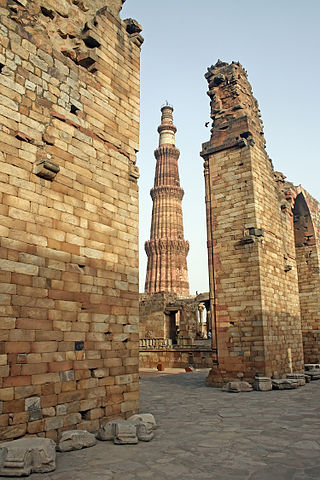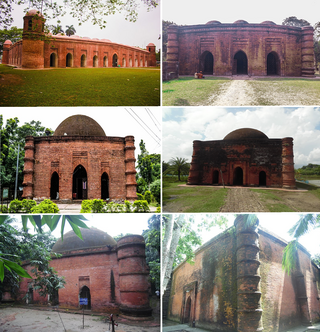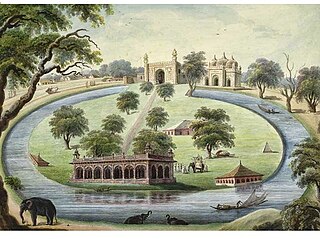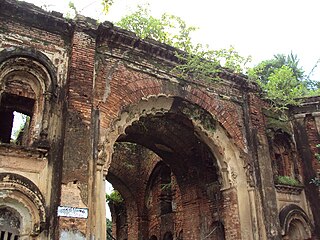
The Qutb Minar complex are monuments and buildings from the Delhi Sultanate at Mehrauli in Delhi, India. Construction of the Qutub Minar "victory tower" in the complex, named after the religious figure Sufi Saint Khwaja Qutbuddin Bakhtiar Kaki, was begun by Qutb-ud-din Aibak, who later became the first Sultan of Delhi of the Mamluk dynasty. It was continued by his successor Iltutmish, and finally completed much later by Firoz Shah Tughlaq, a Sultan of Delhi from the Tughlaq dynasty (1320–1412) in 1368 AD. The Qubbat-ul-Islam Mosque, later corrupted into Quwwat-ul Islam, stands next to the Qutb Minar.

Mir Syed Jafar Ali Khan Mirza Muhammad Siraj-ud-Daulah, commonly known as Siraj-ud-Daulah or Siraj ud-Daula, was the last independent Nawab of Bengal. The end of his reign marked the start of the rule of the East India Company over Bengal and later almost all of the Indian subcontinent.

Murshidabad is a historical city in the Indian state of West Bengal. It is located on the eastern bank of the Bhagirathi River, a distributary of the Ganges. It forms part of the Murshidabad district.

Mughal architecture is the type of Indo-Islamic architecture developed by the Mughals in the 16th, 17th and 18th centuries throughout the ever-changing extent of their empire in the Indian subcontinent. It developed from the architectural styles of earlier Muslim dynasties in India and from Iranian and Central Asian architectural traditions, particularly Timurid architecture. It also further incorporated and syncretized influences from wider Indian architecture, especially during the reign of Akbar. Mughal buildings have a uniform pattern of structure and character, including large bulbous domes, slender minarets at the corners, massive halls, large vaulted gateways, and delicate ornamentation; examples of the style can be found in modern-day Afghanistan, Bangladesh, India and Pakistan.

The Mosque City of Bagerhat is a UNESCO World Heritage Site in Bagerhat District, Bangladesh. It contains 360 mosques, public buildings, mausoleums, bridges, roads, water tanks and other public buildings constructed from baked brick. The mosques were built during the Bengal Sultanate in the 15th century, of which the Sixty Dome Mosque is the largest. Other mosques include the Singar Mosque, the Nine Dome Mosque, the Tomb of Khan Jahan, the Bibi Begni Mosque and the Ronvijoypur Mosque. The mosques were built during the governorship of Ulugh Khan Jahan, a Turkic military officer appointed as governor in the Sundarbans by Sultan Mahmud Shah of Bengal.

The Nawab of Bengal was the hereditary ruler of Bengal Subah in Mughal India. In the early 18th-century, the Nawab of Bengal was the de facto independent ruler of the three regions of Bengal, Bihar and Orissa which constitute the modern-day sovereign country of Bangladesh and the Indian states of West Bengal, Bihar and Odisha. The Bengal Subah reached its peak during the reign of Nawab Shuja-ud-Din Muhammad Khan. They are often referred to as the Nawab of Bengal, Bihar and Orissa. The Nawabs were based in Murshidabad which was centrally located within Bengal, Bihar, and Odisha. Their chief, a former prime minister, became the first Nawab. The Nawabs continued to issue coins in the name of the Mughal Emperor, but for all practical purposes, the Nawabs governed as independent monarchs. Bengal continued to contribute the largest share of funds to the imperial treasury in Delhi. The Nawabs, backed by bankers such as the Jagat Seth, became the financial backbone of the Mughal court.

The Sixty Dome Mosque, is a mosque in Bagerhat, Bangladesh. It is a part of the Mosque City of Bagerhat, a UNESCO World Heritage Site. It is the largest mosque in Bangladesh from the sultanate period (1352–1576). It was built during the Bengal Sultanate by Khan Jahan Ali, the governor of the Sundarbans. It has been described as "one of the most impressive Muslim monuments in the whole of South Asia."

Indo-Islamic architecture is the architecture of the Indian subcontinent produced by and for Islamic patrons and purposes. Despite an initial Arab presence in Sindh, the development of Indo-Islamic architecture began in earnest with the establishment of Delhi as the capital of the Ghurid dynasty in 1193. Succeeding the Ghurids was the Delhi Sultanate, a series of Central Asian dynasties that consolidated much of North, East, and Central India, and later by the Mughal Empire during the early 16th century. Both of these dynasties introduced Islamic architecture and art styles from West Asia into the Indian subcontinent.

The Architecture of Bengal, which comprises the modern country of Bangladesh and the Indian states of West Bengal, Tripura and Assam's Barak Valley, has a long and rich history, blending indigenous elements from the Indian subcontinent, with influences from different parts of the world. Bengali architecture includes ancient urban architecture, religious architecture, rural vernacular architecture, colonial townhouses and country houses and modern urban styles. The bungalow style is a notable architectural export of Bengal. The corner towers of Bengali religious buildings were replicated in medieval Southeast Asia. Bengali curved roofs, suitable for the very heavy rains, were adopted into a distinct local style of Indo-Islamic architecture, and used decoratively elsewhere in north India in Mughal architecture.

Tourism in Bangladesh includes tourism to World Heritage Sites, historical monuments, resorts, beaches, picnic spots, forests, tribal people, and wildlife of various species. Activities for tourists include angling, water skiing, river cruising, hiking, rowing, yachting, beachgoing and sea bathing.

Motijhil, also known as Company's Lake due to its association with the East India Company, is a horse-shoe shaped lake in Murshidabad, West Bengal, India. It was created by Nawazish Muhammad Khan, the son-in-law of Nawab Alivardi Khan. He also constructed a precious palatial palace beside this lake which is called the Sang-i-Dalan which is also known as the Motijhil Palace. It is located at the bend of this lake. It was used as the residence of Nawazish and Ghaseti Begum, Nawazish's beloved wife. It is said that after Nawazish died, Ghaseti Begum lived here until Nawab Siraj ud-Daulah took over the palace and seized the residents' in 1756 AD. With this money he built a similar lake with a beautiful palace, Hirajheel, on the opposite side of the Hooghly River. The palace has a lofty gateway, a mosque known as the "Shahamat Jang" and the Kala Masjid and some other buildings which were all built by Nawazish. This palace was built in 1740. As far as etymology is concerned, the palace has been named so as it was built using black basalt pillars which were brought from the ruins of Gaur. Thus, it was given the name of Sang-i-Dalan or the Stone Palace. This palace was then decorated with different varieties of flower plants and precious marbles.

Namak Haram Deorhi was the palace of Mir Jafar. It is located just opposite to the Jafarganj Cemetery in the Lalbagh area of the town of Murshidabad and near Mahimapur in the Indian state of West Bengal. Namak Haram Deorhi refers to both the place of Mir Jafar and the main gate which leads to the palace. This building was used as the residence of Mir Jafar, before he ascended the musnad of Bengal or when he was the Commander-in-Chief of the subha.

Persian Inscriptions on Indian Monuments is a book written in Persian by Dr Ali Asghar Hekmat E Shirazi and published in 1956 and 1958 and 2013. New edition contains the Persian texts of more than 200 epigraphical inscriptions found on historical monuments in India, many of which are currently listed as national heritage sites or registered as UNESCO world heritage, published in Persian; an English edition is also being printed.

Khushbagh is the garden-cemetery of the Nawabs of Bengal, situated on the west bank of the Hooghly river, about a mile from its east bank, in the Murshidabad-Jiaganj CD block in Lalbag subdivision of Murshidabad district, West Bengal, India. Khushbagh hosts the graves of the Nawabs of Bengal of the Afshar dynasty and their family members; while Jafarganj Cemetery hosts the graves of the later Nawabs and their families, starting from Mir Jafar, who belonged to the Najafi dynasty. Khushbagh is the resting place of Nawab Siraj ud-Daulah, his wife Lutf-un-nisa, Nawab Alivardi Khan, and his mother, amongst others.

Asrafia Jame Masjid, previously known as the Mosque of Ahladi Bibi, is a mosque located in the urban neighbourhood of Amlapara, in the city of Narayanganj, Bangladesh. It was built during the British Raj colonial period, dating back to the 1890s.
Lucknow is known as a city of imambaras as it contains a large number of them, among which, some are very well known.

Shia Muslims are a minority in Bangladesh, with roughly 2% of the population being Shia. Many Bangladeshi Shi'a Muslims belong to the Bihari community. Even though there are only small numbers of Shi'as, the observance commemorating the martyrdom of Ali's sons, Hasan and Husayn, are still widely observed by the nation's Sunni community; highlighting the historical influence that the Shi'ites had in Bengal.

Jama Masjid is a congregational mosque located at Motijhil, in the historic city of Murshidabad, West Bengal, India.

The Afzal Gunj Masjid, also known as AfzalGunj Masjid or Afzalgunj Mosque, is a mosque located in the Afzalgunj, Hyderabad, India. The mosque was constructed in 1866 by Afzal-ud-Daulah, the fifth Nizam of Hyderabad, after the construction of Nayapul which connects the city with its new establishment. The mosque is constructed in a style of three arched facade and the two minarets in the front corner of rectangular hall.

Chandanpura Nachghar is an ancient building located adjacent to Chandanpura Fire Service Station, along Nawab Siraj-ud-Daulah road in Chittagong, Bangladesh. The dance hall of this zamindar house is located next to the fire service station. It is known as the dance hall of the zamindar house of Sajjalela. The building was once used as the Chittagong Divisional Fire Service Office. It is currently preserved as the proposed Fire Service and Civil Defense Museum. The Bangladesh government declared the building abandoned 25 years ago in the 1990s.



























